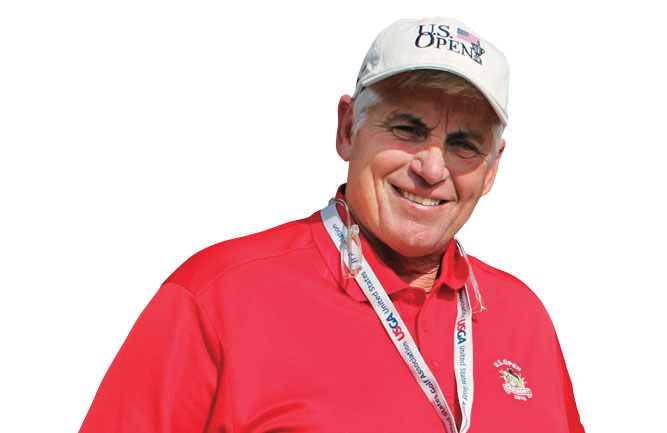Merrily they roll along…down the fairway
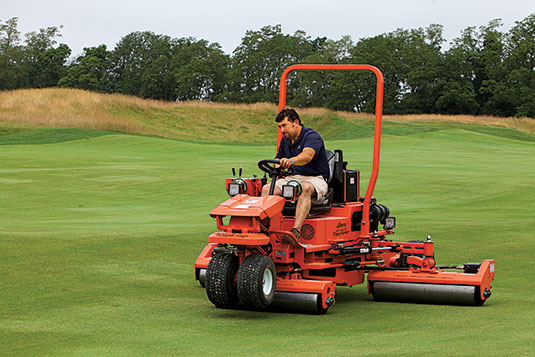
Fairway rolling, which has been a relatively minor golf course maintenance practice for decades, has been upgraded for the 21st Century. New rollers, and new reasons to use them backed by research, mean more superintendents are rolling fairways.
And before long, you may be rolling, too.
It’s said that sooner or later, everything old is new again. Whether you believe that or not (it’s also said that 50 is the new 40), it just may be true for the practice of rolling golf course fairways. What had been an off again/on again cultural tool of the 20th Century appears to be a trend on golf courses of the 21st Century.
In the olden days (when 50 was still just 50), rollers had a place on fairways during construction, or maybe in the spring after a course had experienced winter frost heaving and needed to be smoothed out before the season’s first mowing.
But the benefits of modern fairway rolling are starting to stack up. They include dollar spot suppression, less cutting time and the accompanying mower-wear reduction, and reduced fungicide applications.
Roller redux
Sal Rizzo, founder of Cheshire, Conn.-based Salsco, which since 2012 has marketed the stand-alone Tranz-Former fairway roller (so named because it folds up – transforms – to go over narrow bridges to the next fairway), says the idea was brought to him by a superintendent.
“Matt Shaffer from Merion Golf Club (Ardmore, Pa.) asked if I had any interest in a new project… He was looking for a machine to roll fairways… I gave him a machine that was wide enough to roll the fairway 10 feet wide and maneuverable enough to roll greens in under three minutes each.”
The benefits, says Rizzo, who exhibited the Tranz-Former at the San Diego Golf Industry Show, are well understood. “Rolling grass has been around forever. It isn’t new. It eliminates dollar spot, smooths the surface and improves the appearance of the fairway. Most superintendents will skip a mowing or two and roll instead. This can double the life of the fairway mowers. The savings, along with the savings of chemicals for dollar spot, will show a return.”
But don’t call it a trend, he says. “It is not a trend. It is here to stay. It improves the course while saving dollars. It is hard to think anyone would not be planning to start the practice of rolling the whole course.”
Offering another take on fairway rolling equipment — towed rollers — is Wayne, Pa.-based Smithco, which also exhibited in San Diego. The company’s new five-gang Ultra 15 roller rolls a 15-foot swath, and at 10 miles per hour will roll 18 acres per hour, which Smithco President Don Smith says is three times faster than mowing. The company’s year-old, three-gang unit, the Ultra 10, has a 10-foot swath and completes 12 acres at a 10-mile-per-hour pace.
The company was drawn into the market two years ago after seeing a couple of models at the GIS. “After some preliminary research on the concept of rolling fairways,” Smith says, “we decided to pursue a simple, cost-effective machine to accomplish the task. Not very many clubs have an extra $45,000 to $50,000 for this, nor that many extra fairway mowers that could be converted; not to mention the downside of using older machines that might be prone to hydraulic leaks. Our Fairway 10 Ultra came out of these discussions as a simple, affordable alternative to the market.”
Smith’s faith in that market is solid, and he notes that he has seen three or four other models at recent shows.
“Fairway rolling (now) is where greens rolling was in 1992,” he says. “I can remember superintendents walking into the booth in New Orleans, looking at our greens roller and chuckling. A typical comment was, ‘Yeah, I’ll roll greens. Never!’ Look where we are in 2016.”
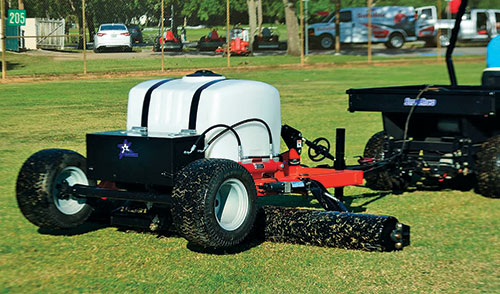
Tow-behind fairway rollers feature water tanks that allow superintendents to adjust the psi applied to turf.
What the research says
An important aspect of golf course maintenance missing from fairway rolling in the days of yore is coming to the foreground in the new century: research.
Among the first turfgrass scientists looking into the practice are Geunhwa Jung, Ph.D., along with research assistant Jay Popko, at the University of Massachusetts-Amherst’s Stockbridge School of Agriculture.
Preliminary results of their field studies are promising for superintendents currently rolling fairways and for those thinking about it. Jung says the practice has the potential of becoming a “game-changer” in the turfgrass industry because of “potential” physical changes in plants, thatches and soils and the microbial composition associated with them. These changes, he notes, may justify reevaluation of currently used cultural practices and chemicals.
“Our tests included rolling plots three times a week, four times a week, six times a week, and leaving some unrolled. We saw reduced clipping yield that positively correlated with increased rolling frequency,” Jung says. “We also tested different fungicide spray schedules, and initial results indicate rolling can reduce the need for fungicide applications if superintendents use threshold-based spray programs. If we can confirm this with our second-year tests, this could save courses some money.”
Jung and Popko also observed differences in the soil profile, and rolled treatments did not have a distinct thatch layer like the non-rolled treatment.
“We observed that the thatch layer has been pushed into the soil,” says Popko, “and further tests are being completed to quantify the organic matter in the top of the soil profile.” Moreover, soil penetrometer tests “confirmed that rolled plots have higher resistance to penetration.” The soil profile alterations may lead to increased breakdown of the thatch layer or explain anecdotal reports from superintendents of increased driving distance on rolled fairways. In addition, the researchers say, future studies will examine ball roll in an attempt to quantify these observations.
At Michigan State University, Thomas Nikolai, Ph.D., has been looking at the effects of rolling greens since the 1990s, and he, along with graduate assistant Thomas Greene, have about three years of fairway rolling research under their belts. However, those studies were hampered by not actually having a fairway roller and having to use a greens roller instead. Nikolai is now looking at three courses that are using Smithco rollers on fairways.
“I know of all the benefits on a golf course green because we’re rolling,” Nikolai says. “I know the difference in weight, and how it impacts the green. The fairways, we don’t know the answers to yet, and what we want the footprint of that roller to be.”
However, there are answers on some advantages. “Rolling on a green actually changes the microbial population in the soil over time,” he says. “The change is probably the biggest reason why we see a reduction in disease. Research done by Paul Giordano here at Michigan State shows that we increased bacteria populations. Most bacteria are beneficial to our plant and antagonistic to fungi. That’s why rolling has that impact, and rolling more leads to greater water retention in the soil. With greater water retention we get greater bacteria, and with greater bacteria we get less disease.”
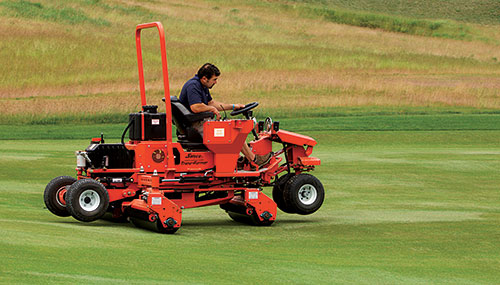
According to Salsco founder Sal Rizzo, the benefits of rolling fairways, including reducing dollar spot, are well understood.
With higher fairway mowing heights, greater thatch accumulation and different soil types, “we’re going to need a heavier roller,” Nikolai says, “but we don’t want the roller to weigh too much. What we still have to do with research is figure out how much. What’s the range we would like that roller to weigh, minimum to maximum?”
Nikolai’s current on-course research is looking to spot decreases in weeds and disease (mostly dollar spot), and increases in golfer satisfaction. He also notes that his previous research turned up no evidence that rollers transfer disease from one spot on the course to another, although “there are still more unknowns than knowns when it comes to the fairway.”
“If you have the time and have the machine, I would stop applying pesticides,” he suggests to superintendents. “I would pick two par 3s and roll half the fairway and not roll the other half. Do a little experiment. If you’re not getting results and you have something that you can add water to and increase the psi, I would put more water in the drum. Try to find the (correct) psi yourself.
“We’re getting there with research,” Nikolai says, but on some agronomic benefits, “the jury’s still out.”
Ask the man who owns one
On the superintendent side, one convert to fairway rolling is Tim O’Neill, CGCS at the Country Club of Darien (Conn.), and a former president of the GCSAA. O’Neill was an early adapter of Salsco’s Tranz-Former, which he’s had for about three years.
“Before I had the Tranz-Former,” he says, “I had the notion that having something to smooth out my fairways would be good, but it had to be something wider than a regular greens roller.”
As far as solid bottom-line results, O’Neill sees them. Saving mower wear and tear allows his mechanic to do other things, he says, “and in the summertime we can skip the middle mowing of the week when things are hot.” The fairway roller was what he was looking for, “because I actually had found myself trying to roll fairways with a small greens roller, which was ridiculous.”
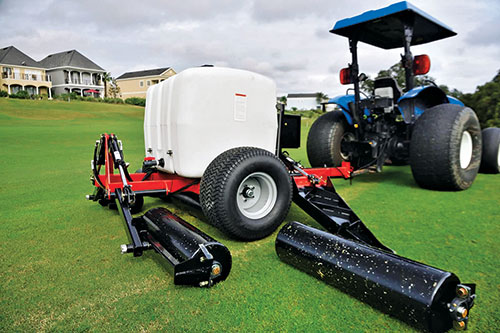
According to Michigan State’s Thomas Nikolai, more research is needed to determine optimal weight for fairway rollers. “We don’t want the roller to weigh too much,” he says.
In a bit of irony, the superintendent who once rolled fairways with a greens roller now rolls greens with a fairway roller. “I have small greens here,” O’Neill says, “so you wouldn’t necessarily think that you would put it on the greens, but for the amount of time we do it… I would say that the machine has a number of different benefits.”
One benefit O’Neill has heard about but not experienced is the reduction in fungicide use. “I’m on a pretty rigid spray program in the summertime,” he notes, “and I haven’t changed it at all because of the roller. But I’ve definitely found other uses for it.” Besides greens, he says, “we use it on the approaches. We use it in areas that may get damaged by vehicles, whether it’s trucks or whatever. After doing a lot of tree work this winter I’ll wait for the right moment, and when things are soft enough or firm enough… I’ll put that machine out there to roll it out and flatten some of the ruts.”
And what about the question of the more expensive stand-alones versus the less-expensive tow-behinds?
“I’m all for the whole notion of rolling,” O’Neill says, “and if you can get it done with those tow-behinds, OK. Whatever fits your budget, if you’re not so worried about tire marks. I like the ability to not have to tow this thing so that there are no wheel marks from a tractor or a heavy-duty utility cart.
“Quite honestly,” he says, “I’m thinking about putting another fairway roller on my equipment needs list, and that could be a three-year process to get it from where that would start to when I could actually get one.”
Photos: Epic Creative, Smithco









